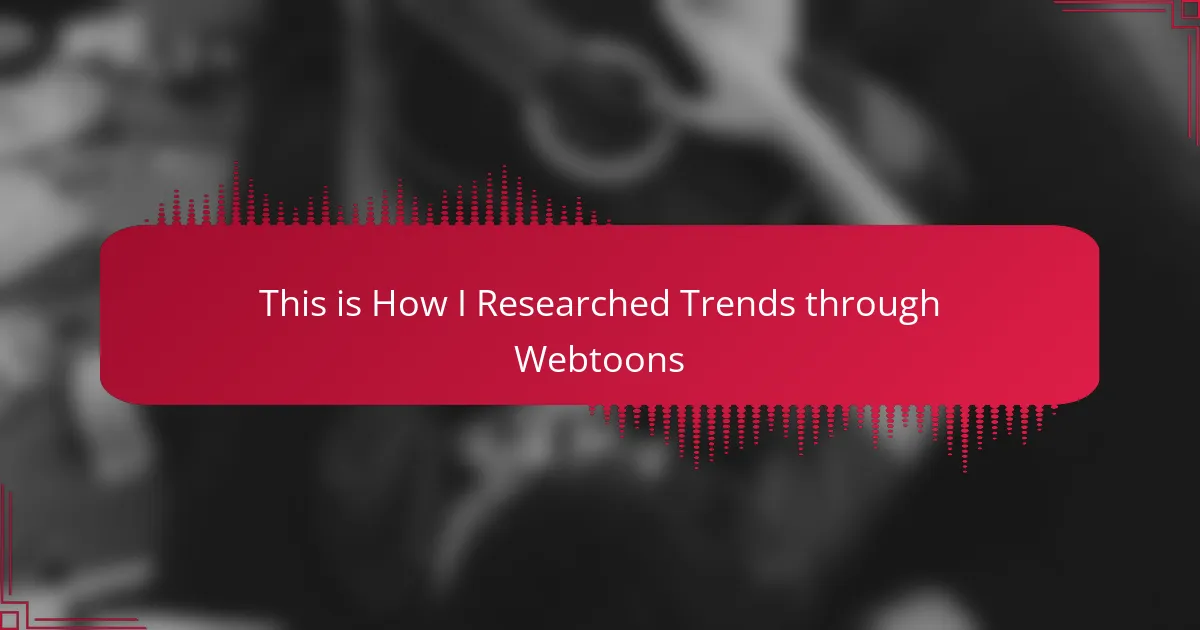Key takeaways
- Webtoons offer unique storytelling and art styles that reflect cultural shifts and resonate with diverse audiences.
- Engagement with reader feedback and trends can shape creative direction and improve storytelling techniques.
- Vibrant visuals and relatable themes, such as love and friendship, enhance reader connection and boost audience engagement.
- Community interaction is crucial for personal and professional growth, fostering dialogue between creators and audiences.
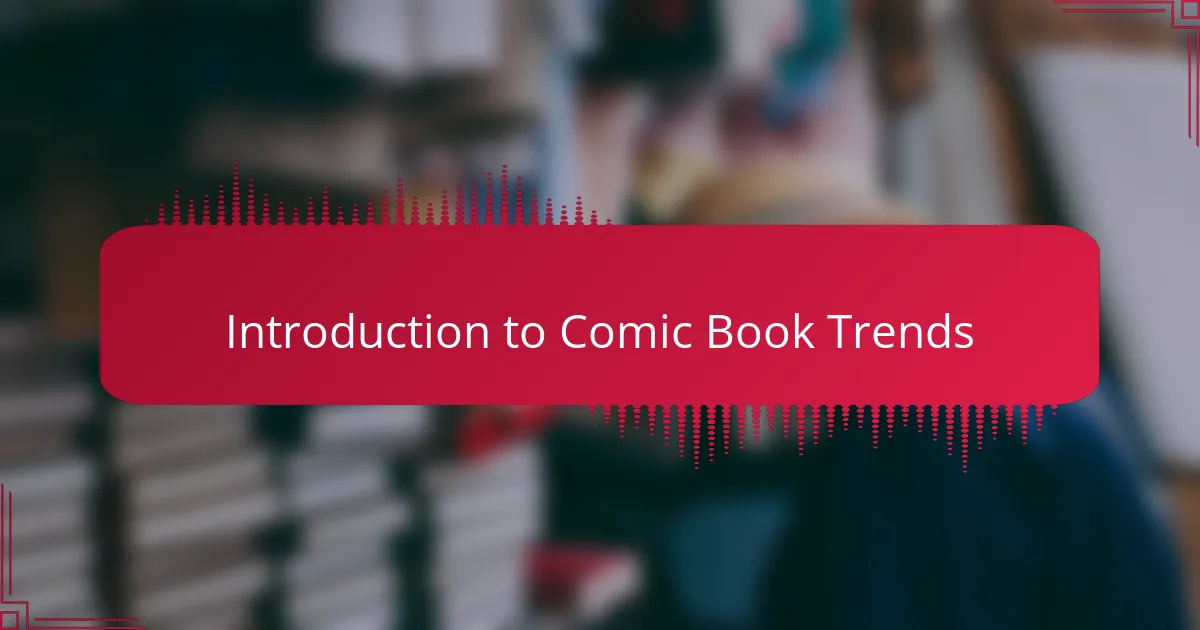
Introduction to Comic Book Trends
When I began my journey into webtoons, I quickly became fascinated by how these digital comics reveal evolving trends in storytelling and art style. It’s incredible to see how diverse narratives resonate with audiences, reflecting cultural shifts and emerging interests. The connection I felt with readers while exploring these trends was not just enlightening; it was a source of inspiration for my own creative projects.
There’s something unique about webtoons—they often break traditional comic book molds. They embrace a wide array of genres and themes, making them accessible to a broader audience. This fluidity allows both fans and creators like myself to engage with trends that perhaps might not find as much space in traditional print comics.
| Trend | Webtoons | Traditional Comics |
|---|---|---|
| Accessibility | Available on various platforms, instant access | Generally requires physical purchase or subscription |
| Art Style | Often colorful, dynamic, and experimental | More varied, but can lean towards classic styles |
| Narrative Styles | Often serialized, focusing on cliffhangers | Typically episodic or standalone issues |
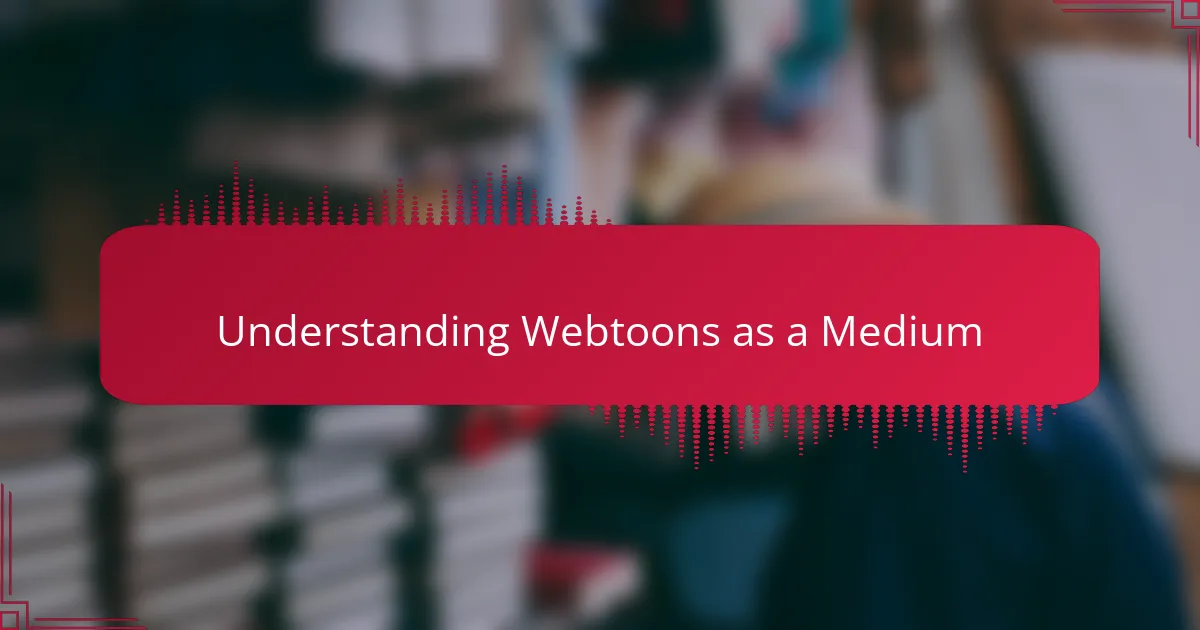
Understanding Webtoons as a Medium
Webtoons as a medium are a delightful blend of creativity and accessibility. I remember the first time I scrolled through a webtoon on my phone; the vibrant art pulled me in instantly. It struck me how these stories are delivered in bite-sized formats, perfect for our fast-paced lives yet rich enough to keep me invested.
The unique structure of webtoons, often serialized with cliffhangers, changes how I engage with a story. It creates a sense of anticipation that I just adore. When I finish an episode, I can’t help but wonder what might unfold next—it’s like a conversation with friends where you’re left hanging, excitedly speculating about the next chapter.
Moreover, the experimental art styles in webtoons inspire me as a creator. I see artists pushing boundaries with colors and layouts in ways traditional comics sometimes shy away from. It fuels my imagination and pushes me to consider how I can incorporate similar bold choices into my own work. Have you ever felt that spark of inspiration from seeing someone break the mold? That feeling is what makes webtoons a transformative medium for both creators and audiences alike.
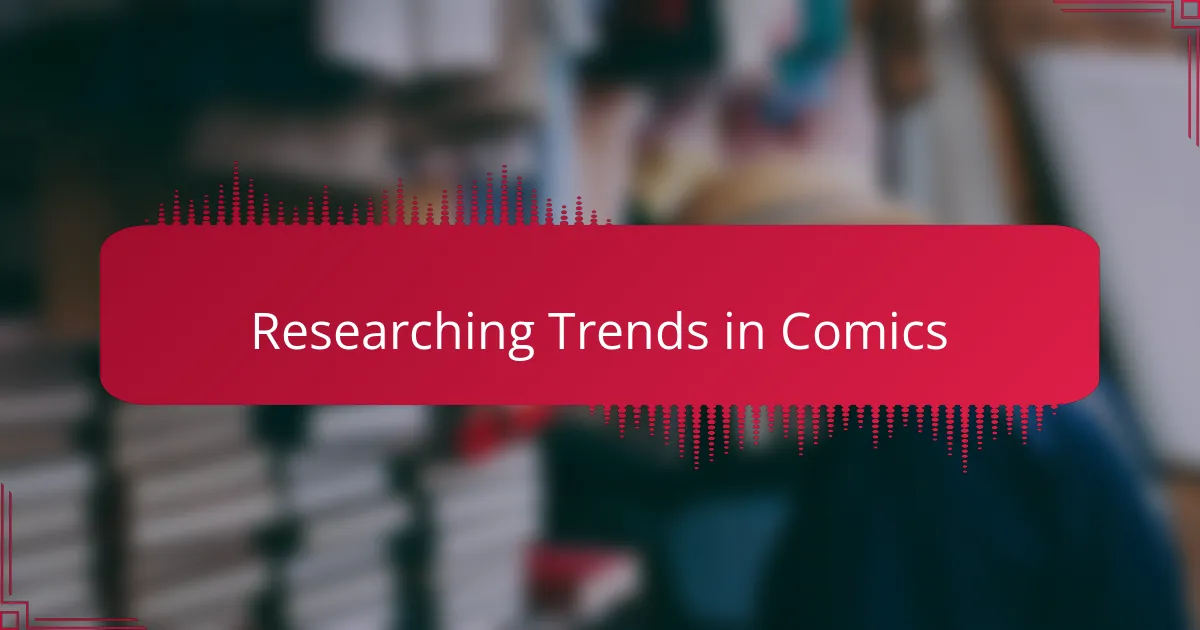
Researching Trends in Comics
Researching trends in comics is a fascinating journey that reveals just how dynamic this medium is. I often find myself diving into different genres, noting how themes shift in response to societal changes. For instance, the rise of mental health narratives in webtoons resonated with me deeply, as I, too, have experienced the importance of representation in storytelling. Have you ever stumbled upon a story that felt like it was speaking directly to your experiences?
When I analyze popular webtoons, I look beyond just the art and plot; I pay attention to the audience’s feedback and engagement. By reading comments and participating in discussions, I gain insights into what captivates readers. This method not only keeps me informed but also strengthens my connection with the audience. Seeing what excites them often shapes my own creative direction, reminding me that we’re all in this storytelling adventure together.
Another fascinating aspect of trend research is tracking the shifts in formats and delivery. I have noticed how the episodic nature of many webtoons has captivated younger audiences accustomed to digital consumption. It’s intriguing to think about how this immediacy influences my writing style and pacing. Have you considered how the format might change the way you create or consume stories? Understanding these trends is less about following them and more about embracing change in a way that feels authentic to both me and my readers.
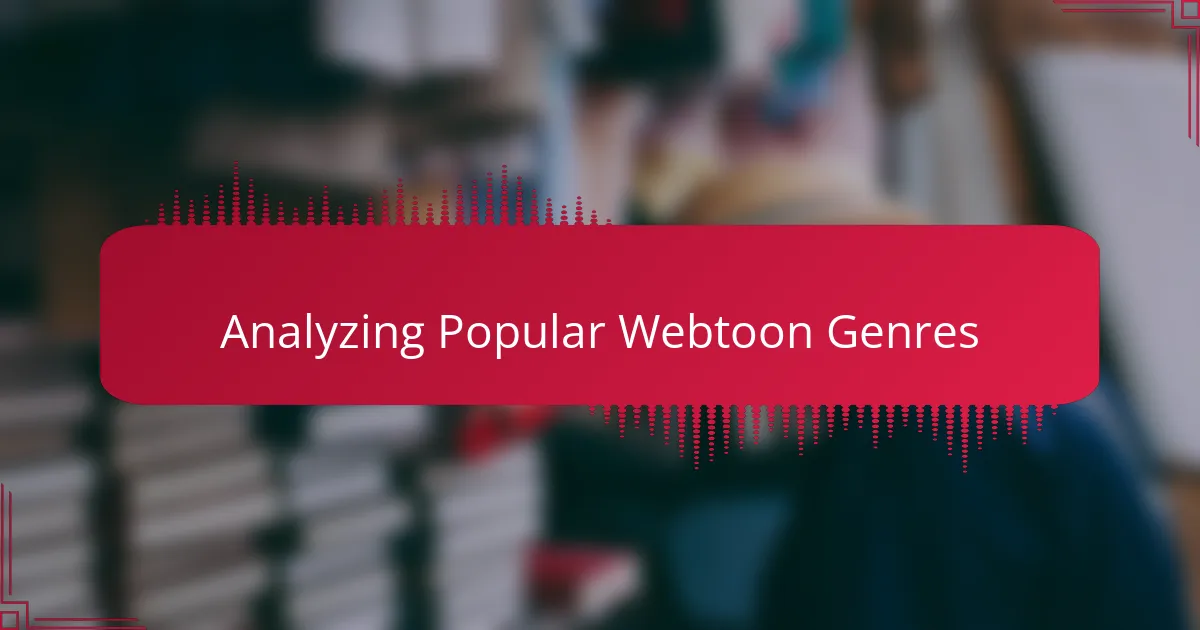
Analyzing Popular Webtoon Genres
When I analyze popular webtoon genres, it’s easy to spot patterns that reflect what readers are craving. For example, romance consistently draws large audiences, often intertwined with elements of drama or fantasy. I remember getting hooked on a webtoon that blended sweet romance with a dash of magical realism. The way it resonated with my own desires for escapism was truly captivating.
Thriller and horror genres have also gained traction in webtoons, and I find that they tap into our collective fascination with suspense. One webtoon, in particular, had me on the edge of my seat with its mind-bending twists. It made me realize that people are often looking for stories that challenge their perceptions and evoke strong emotions. Have you ever found yourself engrossed in a story that made your heart race or sent chills down your spine?
Historical and adventure genres are emerging as well, providing a rich canvas for exploration. I love how detailed storytelling in these genres can transport you to different times and places, instilling a sense of wonder. I often reflect on how these narratives inspire curiosity about the past and encourage readers to consider the lessons history has to offer. This blend of education and entertainment is something I strive to achieve in my own writing.
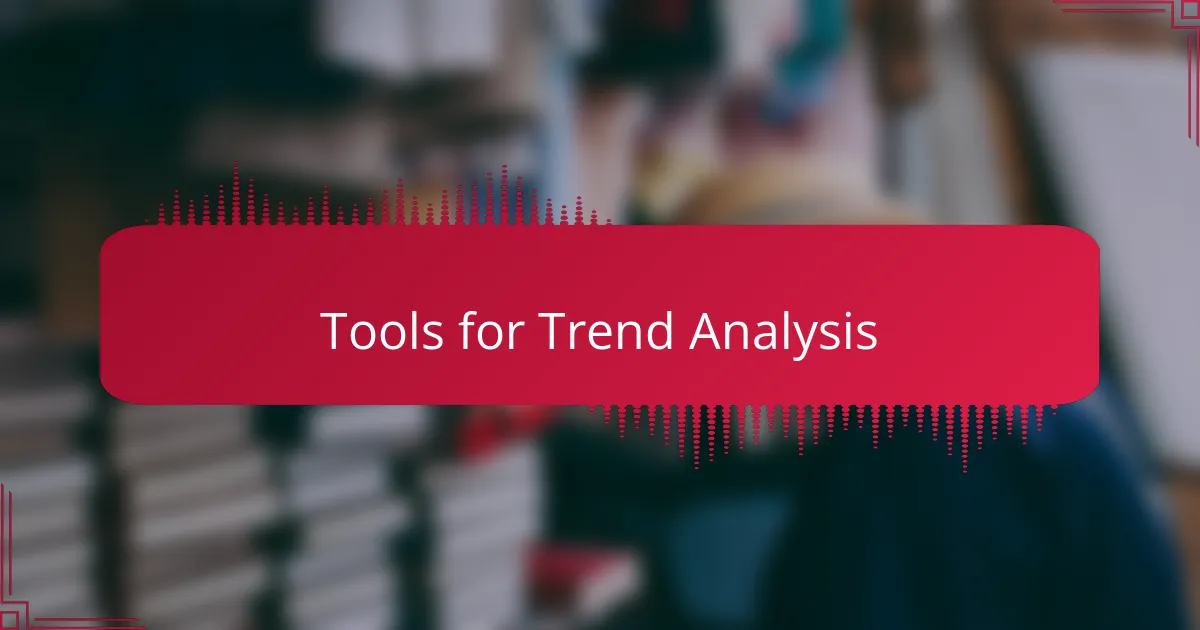
Tools for Trend Analysis
When it comes to analyzing trends, various tools can make the process much smoother. I’ve often relied on Google Trends to see which webtoon titles are gaining traction. It’s fascinating to input different keywords and watch the interest levels shift over time. Have you tried using it? The visual graphs are not just informative; they tell a story about what captures the audience’s attention at any given moment.
Another tool that I find invaluable is social media analytics. Platforms like Twitter and Instagram provide insights into engagement metrics for webtoons. I’ve seen firsthand how a simple tweet or post can ignite conversations around a particular title. Engaging with followers offers real-time feedback, and that instant interaction is a wealth of information. It’s almost like having a pulse on the community, and I cherish that connection.
I also suggest checking out platforms like Webtoon itself, where data on viewer counts and subscriber growth is accessible. This empirical data can highlight trends that may not be immediately obvious. I’ve found that comparing this information across different genres helps me identify shifts in reader preferences. Isn’t it amazing how numbers can reveal the heartbeat of our creative community? Each statistic can guide my creative journey in meaningful ways.
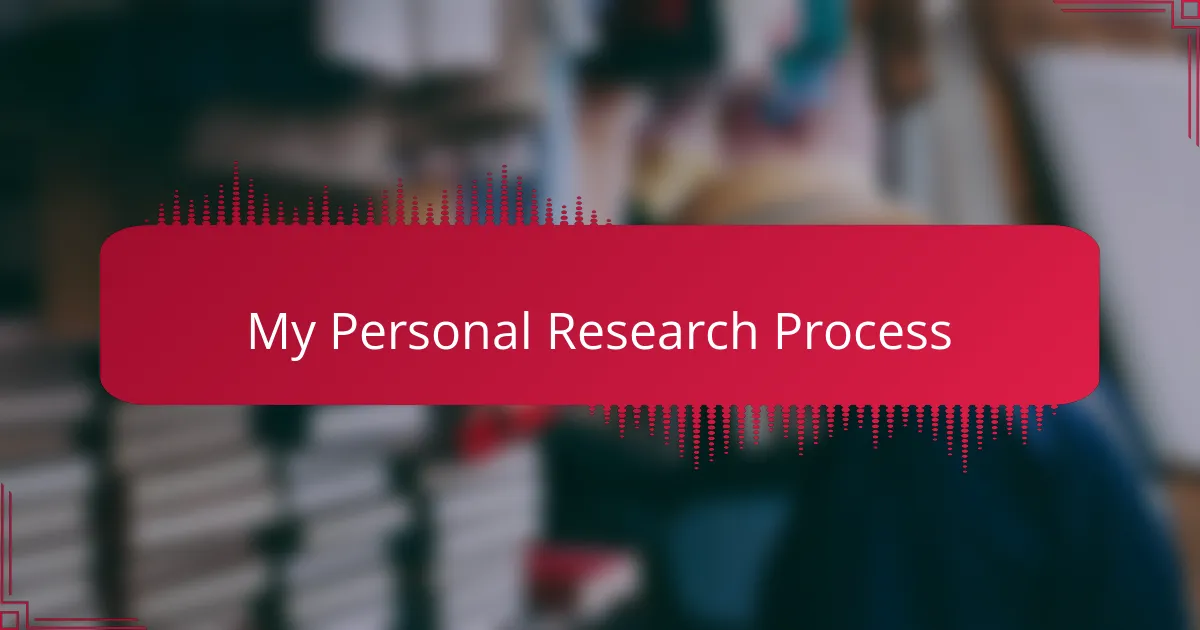
My Personal Research Process
When I dive into researching trends through webtoons, I first immerse myself in various platforms like LINE Webtoon and Tapas. I like to explore popular and newly released series, observing which themes or styles resonate with readers. For example, I remember stumbling upon a webtoon that creatively blended romance with supernatural elements, which inspired me and showed me the unique storytelling possibilities available in this medium.
I often jot down notes on art styles, storytelling techniques, and character development as I scroll through. I also take note of reader comments and ratings, as they can provide invaluable insight into what captivates audiences. One time, I noticed that a particular slice-of-life series garnered a lot of praise for its relatable characters, which helped me understand the importance of creating believable protagonists in my own work.
Here’s a helpful comparison table that summarizes my research approach:
| Research Tool | Observation Focus |
|---|---|
| Webtoon Platforms (LINE, Tapas) | Trends in themes, audience reactions, art styles |
| Reader Comments | Insights into character relatability, plot engagement |
| Note-taking | Documenting techniques and personal reactions |
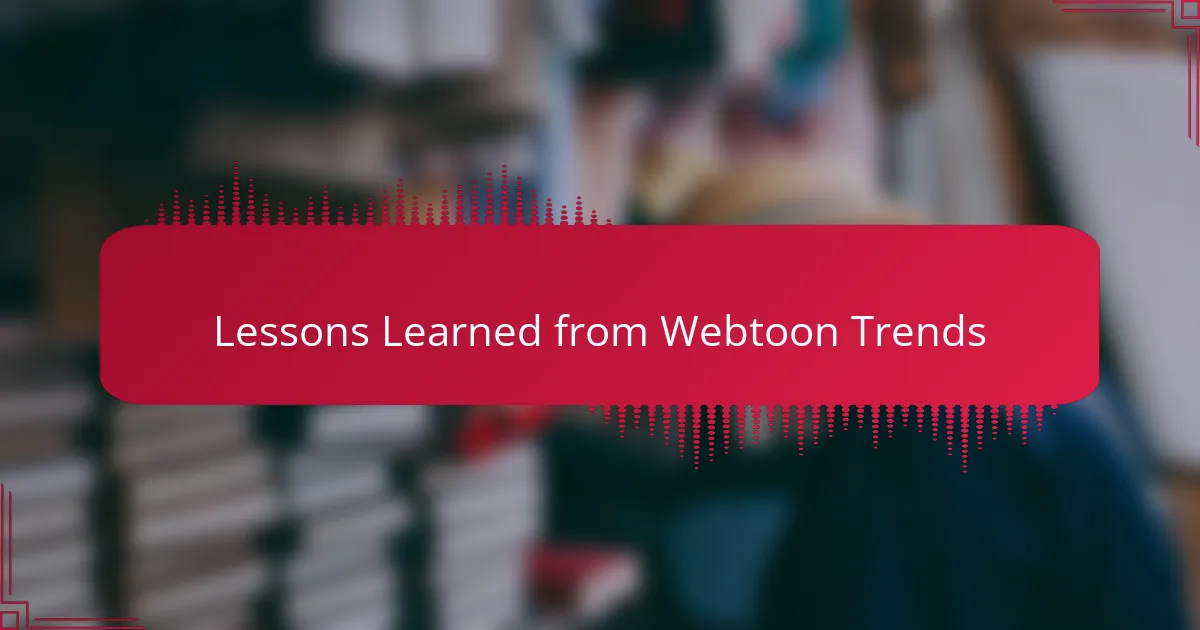
Lessons Learned from Webtoon Trends
When diving into the world of Webtoon trends, I found that storytelling elements play a crucial role in connecting with readers. For instance, I noticed how themes of love, friendship, and self-discovery consistently resonated. This insight encouraged me to experiment with these themes in my own work, making my narratives more relatable and impactful.
Another valuable lesson was the importance of engaging visuals. I discovered that vibrant art styles tend to attract more viewers. Reflecting on my own experiences, I realized that investing time in enhancing my artwork not only improved reader engagement but also boosted my confidence as an artist.
Lastly, I learned that community interaction is essential. The feedback loop provided by Webtoon readers helped me understand what aspects of my stories worked and which could be improved. I started nurturing a dialogue with my audience, which has been incredibly rewarding both personally and professionally.
| Lesson | Details |
|---|---|
| Storytelling Elements | Themes of love, friendship, and self-discovery resonate strongly. |
| Visual Appeal | Vibrant art styles attract more viewers and enhance engagement. |
| Community Interaction | Nurturing feedback from readers fosters improvement and connection. |
